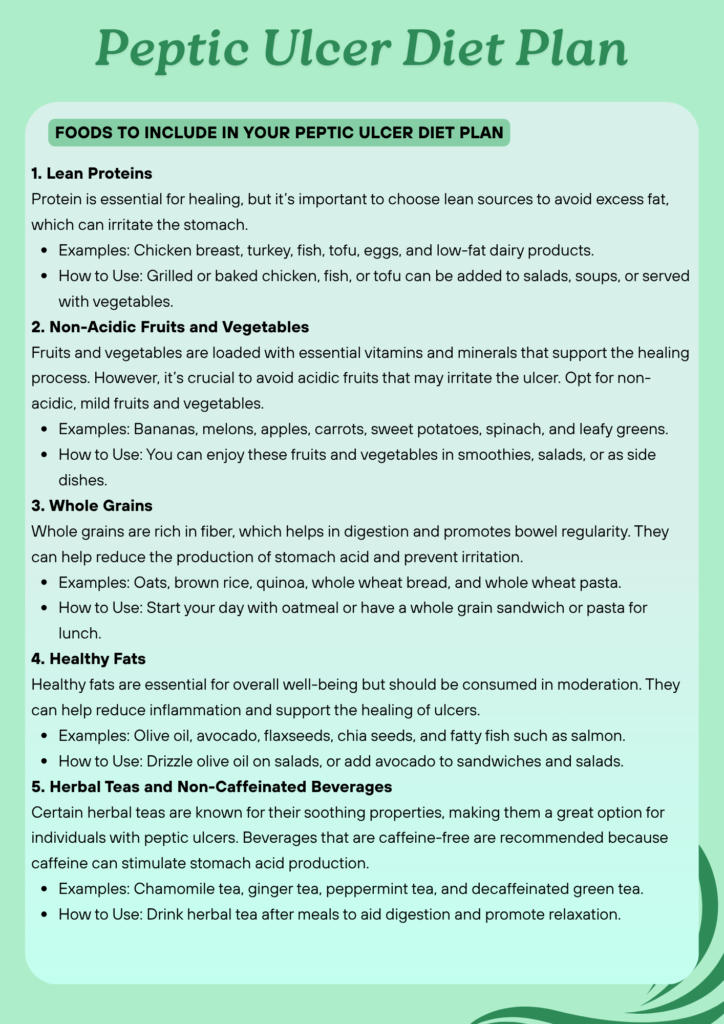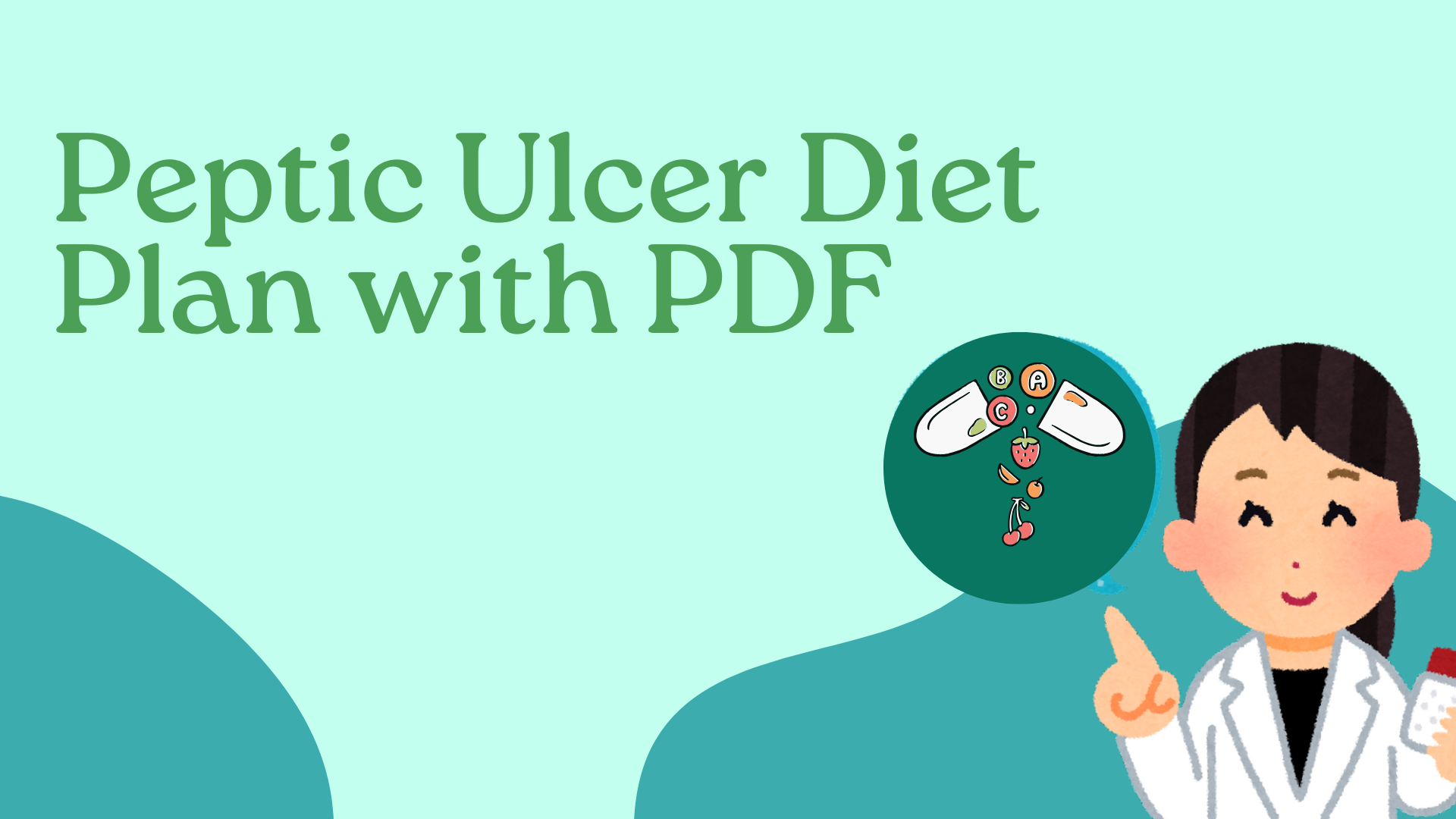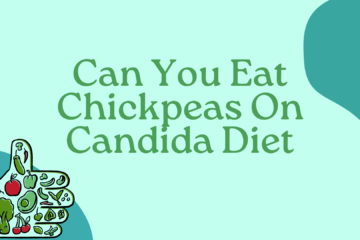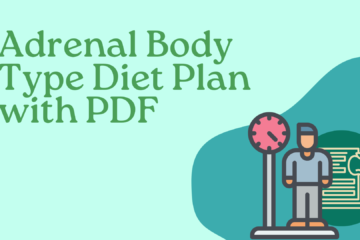A peptic ulcer is a sore that develops on the lining of your stomach, small intestine, or esophagus, and it can cause significant discomfort. Managing a peptic ulcer involves reducing stomach acid production and avoiding foods that could irritate the ulcer.
A peptic ulcer diet plan focuses on foods that soothe the digestive system, promote healing, and prevent aggravating symptoms. Below is a comprehensive diet plan to help manage peptic ulcers and promote healing.
Table of Contents
Foods to Include in Your Peptic Ulcer Diet Plan
Certain foods can be beneficial when managing a peptic ulcer. They help to coat the stomach, reduce irritation, and aid in healing. Here are some food categories you should include in your diet:
1. Lean Proteins
Protein is essential for healing, but it’s important to choose lean sources to avoid excess fat, which can irritate the stomach.
- Examples: Chicken breast, turkey, fish, tofu, eggs, and low-fat dairy products.
- How to Use: Grilled or baked chicken, fish, or tofu can be added to salads, soups, or served with vegetables.
2. Non-Acidic Fruits and Vegetables
Fruits and vegetables are loaded with essential vitamins and minerals that support the healing process. However, it’s crucial to avoid acidic fruits that may irritate the ulcer. Opt for non-acidic, mild fruits and vegetables.
- Examples: Bananas, melons, apples, carrots, sweet potatoes, spinach, and leafy greens.
- How to Use: You can enjoy these fruits and vegetables in smoothies, salads, or as side dishes.
3. Whole Grains
Whole grains are rich in fiber, which helps in digestion and promotes bowel regularity. They can help reduce the production of stomach acid and prevent irritation.
- Examples: Oats, brown rice, quinoa, whole wheat bread, and whole wheat pasta.
- How to Use: Start your day with oatmeal or have a whole grain sandwich or pasta for lunch.
4. Healthy Fats
Healthy fats are essential for overall well-being but should be consumed in moderation. They can help reduce inflammation and support the healing of ulcers.
- Examples: Olive oil, avocado, flaxseeds, chia seeds, and fatty fish such as salmon.
- How to Use: Drizzle olive oil on salads, or add avocado to sandwiches and salads.
5. Herbal Teas and Non-Caffeinated Beverages
Certain herbal teas are known for their soothing properties, making them a great option for individuals with peptic ulcers. Beverages that are caffeine-free are recommended because caffeine can stimulate stomach acid production.
- Examples: Chamomile tea, ginger tea, peppermint tea, and decaffeinated green tea.
- How to Use: Drink herbal tea after meals to aid digestion and promote relaxation.
Foods to Avoid in Your Peptic Ulcer Diet Plan
Some foods and beverages can aggravate peptic ulcers and should be avoided. They can increase stomach acid production, cause irritation, or delay the healing process.
1. Spicy Foods
Spicy foods, such as those containing hot peppers, chili, or curry, can irritate the stomach lining and worsen ulcer symptoms.
- How to Avoid: Skip spicy dishes, including spicy sauces and seasonings, in favor of milder flavors such as herbs and mild spices.
2. Acidic Foods and Beverages
Foods and drinks high in acid can cause irritation to the stomach lining, making the ulcer more painful.
- Examples: Citrus fruits (oranges, lemons, grapefruits), tomatoes, and vinegar-based dressings.
- How to Avoid: Opt for non-acidic fruits and vegetables, and choose low-acid beverages.
3. Fatty and Fried Foods
Fatty and fried foods can stimulate the stomach to produce more acid, which can irritate the ulcer and delay healing.
- Examples: Fried foods, fatty cuts of meat, and full-fat dairy products.
- How to Avoid: Choose lean protein sources like chicken breast, fish, and tofu, and avoid cooking with excess oils or fats.
4. Caffeinated Beverages
Caffeine can increase the production of stomach acid, making it more difficult for the ulcer to heal and potentially causing discomfort.
- Examples: Coffee, regular tea, and caffeinated sodas.
- How to Avoid: Opt for decaffeinated beverages or herbal teas that are soothing to the digestive system.
5. Alcohol
Alcohol can irritate the stomach lining, increase stomach acid, and interfere with the healing process of peptic ulcers.
- How to Avoid: Avoid alcoholic beverages completely during the healing phase and until your doctor advises otherwise.

Sample Peptic Ulcer Diet Plan
Here’s a simple day-by-day meal plan designed to follow the principles of a peptic ulcer diet. This plan can be modified based on personal preferences and nutritional needs.
Day 1:
- Breakfast: Oatmeal with banana slices and a sprinkle of flaxseeds. Herbal tea (chamomile or ginger tea).
- Lunch: Grilled chicken breast with quinoa and steamed spinach. A side of non-acidic fruit like melon.
- Snack: A small handful of almonds or a smoothie with avocado, spinach, and apple.
- Dinner: Baked salmon with mashed sweet potatoes and steamed broccoli.
- Beverages: Drink herbal tea or warm water throughout the day.
Day 2:
- Breakfast: Scrambled eggs with sautéed spinach and a slice of whole-grain toast.
- Lunch: Turkey and avocado wrap with a side of steamed carrots.
- Snack: A small bowl of low-fat yogurt with a handful of blueberries.
- Dinner: Grilled tilapia with brown rice and roasted zucchini.
- Beverages: Drink chamomile tea or water throughout the day.
Day 3:
- Breakfast: Smoothie made with banana, spinach, avocado, and almond milk.
- Lunch: Grilled chicken salad with mixed greens, olive oil, and lemon dressing.
- Snack: Carrot sticks with a small portion of hummus.
- Dinner: Lean beef stew with carrots, celery, and potatoes.
- Beverages: Drink water or herbal tea throughout the day.
Conclusion
A peptic ulcer diet is designed to reduce stomach irritation and promote healing by focusing on lean proteins, healthy fats, non-acidic fruits, vegetables, and whole grains. Avoiding spicy, fatty, and acidic foods is crucial for preventing further irritation. By following these meal ideas and adjusting based on your preferences, you can help manage peptic ulcer symptoms and support your healing journey.
For a more detailed and personalized plan, consider working with a healthcare provider or nutritionist to tailor the diet to your specific needs.




